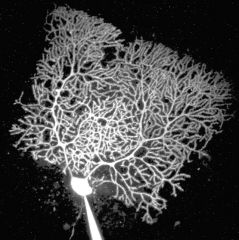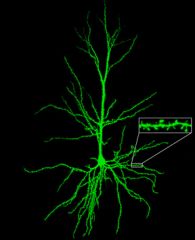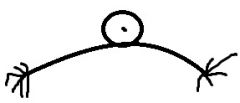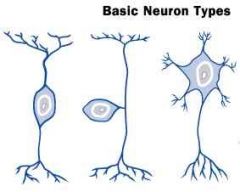![]()
![]()
![]()
Use LEFT and RIGHT arrow keys to navigate between flashcards;
Use UP and DOWN arrow keys to flip the card;
H to show hint;
A reads text to speech;
112 Cards in this Set
- Front
- Back
|
What is another name for a leakage channel?
|
Non gated channel
|
|
|
_________ – gated channels respond to a direct change in the membrane potential
|
Voltage
|
|
|
_________ gated channels respond to a specific chemical stimulus
|
Ligand
|
|
|
_________ gated ion channels respond to mechanical vibration or pressure
|
Mechanically
|
|
|
_______________ ______________ __________ is where a neuron is not actively passing an action potential
|
resting membrane potential
|
|
|
What kind of ions are along the inside of a cell membrane and what kind are along the outside?
|
Negative is along the inside, Positive along the outside
|
|
|
What is the potential energy difference at rest for a voltage gated channel?
|
-70 mV
|
|
|
At resting potential what is the extracellular fluid rich with?
|
Na+ and Cl-
|
|
|
What is the name of the intracellular fluid in cell membrane?
|
Cytosol
|
|
|
What is the cytosol filled with?
|
K+, organic phosphate, and amino acids
|
|
|
K+ is _______ more permeable than Na+
|
50-100
|
|
|
The inward flow of ______ can’t keep up with outward flow of _____
|
Na+, K+
|
|
|
What is another name for the Na+/K+ pump?
|
bilateral dual pump
|
|
|
Hyperpolarization
|
cell has become more negative
|
|
|
Depolarization
|
membrane has become more positive
|
|
|
There is a ______ relationship between strength of stimulus and size of voltage change
|
direct
|
|
|
Why do we need a Na+ pump?
|
Because we have leakage channels that throw off the equilibrium so the pump brings it back to equilibrium
|
|
|
Where do graded potentials occur most often?
|
dendrites and cell body of a neuron
|
|
|
The influx of Na+ produces the _________ phase of the action potential
|
Depolarization
|
|
|
What is an action potential?
|
Series of rapidly occurring events that change and then restore the membrane potential of a cell to its resting state
|
|
|
What is an all or none principal?
|
with stimulation, either happens one specific way or not at all
|
|
|
How fast does an all or none principal happen?
|
1/1000 of a second
|
|
|
When K+ rushes out the cell ______
|
Repolarizes
|
|
|
What does propagation mean?
|
spreading out
|
|
|
Which channel has two gates?
|
Na+
|
|
|
Na+ has how many gates? What are/is their/it's name(s)?
|
2 activation and inactivation
|
|
|
Whether the gate is activated or not depends solely on the ________ gate.
|
activation
|
|
|
What is peak voltage?
|
+30mV
|
|
|
Once peak voltage is reached, what happens next?
|
K+ gate opens and K+ rushes in causing cell to become more negative
|
|
|
What is the absolute refractory period?
|
in the repolarizing phase 3 this means no other action potential can occur because the inactivation gate is closed
|
|
|
What is the relative refractory period?
|
it is possible for an activation potential to occur but it will require a lot more energy because the K+ channel is still open figure 4
|
|
|
What is the biggest axon, middle axon, smallest axon?
|
Biggest: A
Middle: B Smallest: C |
|
|
Axons _ & _ are myelinated.
|
A & B
|
|
|
What are the Nodes of Ranvier?
|
breaks in the mylenation along the axon
|
|
|
What is continuous conduction?
|
where axons that are not mylenated
|
|
|
What fiber is unmyelinated sensory and autonomic motor
|
C
|
|
|
What fiber is myelinated visceral sensory and autonomic preganglionic
|
B
|
|
|
What fiber is myelinated somatic sensory and motor to skeletal muscle
|
A
|
|
|
Agonist
|
anything that not only mimics but enhances a transmitter effects
|
|
|
Antagonist
|
anything that blocks the action of a neurotransmitter
|
|
|
Competitive antagonist
|
gets there faster than what is supposed to go there and sits on the receptor such as CO
|
|
|
Trigger zone
|
area in the axon hillock where the axon tapers off and goes to the cell body
|
|
|
_____________ & ___________ prevent opening of voltage – gated Na+ channels
|
Local anestetics and some neurotransmitters
|
|
|
What happens when Ca+ goes into the synaptic bulbs?
|
it triggers a cascade of events
|
|
|
Receptors
|
structures to which chemical messengers can bind in a lock and key fashion
|
|
|
Bind
|
act of a chemical messenger occupying the binding site of a receptor
|
|
|
Spatial summation
|
1 postsynaptic neuron receiving a message from 2 or more presynaptic neurons
|
|
|
Temporal summation
|
1 postsynaptic neuron receiving a message from 1 presynaptic neuron
|
|
|
Intensity of impulses can be seen in what two ways?
|
frequency and single big blast
|
|
|
Diverging circuit
|
single cell stimulates many others ex: can be found in visual circuitry
|
|
|
Converging circuit
|
one cell stimulated by many others ex: bipolar cells of the eye converging unto ganglion cell
|
|
|
Oscillatory or Reverberating circuit
|
impulses from later cells repeatedly stimulate early cells in the circuit (short – term memory) coordinating muscle activities, waking, sleeping, and breathing
|
|
|
Parallel after discharge circuit
|
single cell stimulates a group of cells that all stimulate a common postsynaptic cell
|
|
|
Can repairs be made to the CNS?
|
yes, extremely slow and minimal repairs
|
|
|
Repair to the axon of a neuron in the PNS can happen as long as what?
|
the damage doesn't reach past the first node
|
|
|
Chromatolysis
|
nissl bodies break up into fine granular masses
|
|
|
Wallerian degeneration
|
degeneration of the distal portion of the axon and myelin sheath
|
|
|
What factors prevent neurogenesis in CNS?
|
inhibition by neuroglial cells, absence of growth stimulating factors, lack of neurolemmas, and rapid formation of scar tissue
|
|
|
Schwann cell mitosis
|
neurolemma on each side of injured axon repairs tube
|
|
|
What happens about 10-20 days after an injury to a neuron?
|
chromatolysis
|
|
|
What happens about the 3rd to 5th day after an injury to a neuron?
|
Wallerian degeneration
|
|
|
Retrograde degeneration of the proximal portion of the fiber extends only to what portion of the axon?
|
the first neurofibral node.
|
|
|
What are the three ways that neurotransmitters can be removed?
|
diffusion, enzymatic degradation, and uptake by nerons or glia cells
|
|
|
Inhibitory postsynaptic potential results from what?
|
Results from the opening of ligand – gated Cl- or K+ channels
|
|
|
Excitatory postsynaptic potential results from what?
|
Results from the opening of ligand – gated Na+ channels
|
|
|
A depolarizing postsynaptic potential
|
Excitatory postsynaptic potential
|
|
|
What axonal flow moves organelles and materials along surface of microtubules?
|
Fast
|
|
|
What axonal flow transports in either direction?
|
Fast
|
|
|
How many mm per day can a fast axonal flow cover?
|
200-400
|
|
|
Which axonal flow moves in one direction only – away from cell body?
|
Slow
|
|
|
How many mm per day can a slow axonal flow cover?
|
1-5
|
|
|
separates charges and put the like ones on one side together resulting in electrical pressure
|
Potential difference
|
|
|
What type of fluid is on the inside of the membrane?
|
Cytosol
|
|
|
At resting potential of an excitable cell which parts are negative? positive?
|
Inner negative, outer positive
|
|
|
What is nicknamed the second brain?
|
Gut
|
|
|
What are the three types of neurons based on function?
|
Sensory neurons (Afferent) pathways, Motor neurons (Efferent), Intermediate/relay/interneuron
|
|
|
What does somatic refer to?
|
body
|
|
|
Approximately how many neuroglia are there per cell?
|
9
|
|
|
All sensory neurons are _____polar
|
uni
|
|
|
Where is the cell body on a sensory neuron?
|
Middle of the axon
|
|
|
Where is the cell body on a motor neuron?
|
At the end
|
|

What kind of neuron is this?
|
Purkinje
|
|

What type of neuron is this?
|
Pyramidal
|
|

What type of neuron is this?
|
sensory
|
|

What kind of neuron is this?
|
motor
|
|

What kind of neurons are these?
|
BIpolar, unipolar, multipolar
|
|
|
What maintains the BBB?
|
Astrocytes
|
|
|
What creates scaffolding for the CNS?
|
Astrocytes
|
|
|
What performs repairs, guiding neuron development?
|
Astrocytes
|
|
|
What controls composition of the extracellular fluid?
|
Astrocytes
|
|
|
What conducts the myelination of neurons in the CNS?
|
Oligodendrocytes
|
|
|
What are the specialized immune cells of the CNS?
|
Microglia
|
|
|
What cells line the chambers and passage filled with CSF?
|
Ependymal cells
|
|
|
What cells assist in the circulation of CSF?
|
Ependymal cells
|
|
|
What cells aid in myelination of neurons in the PNS?
|
Schwann cells
|
|
|
How many Schwann cells are needed to myelinate one axon?
|
1
|
|
|
In the CNS what is the white matter composed of?
|
myelinated axons
|
|
|
In the CNS what is the gray matter composed of?
|
everything but myelinated axons
|
|
|
True or False:
In the spinal cord, gray matter is central. |
True
|
|
|
True or False:
White matter is central in brain |
True
|
|
|
Enteric plexuses help regulate what body system?
|
digestive
|
|
|
What receptors monitor changes in the internal or external environment.
|
sensory
|
|
|
What is the function of sensory neurons?
|
to sense changes in the internal and external environment through sensory receptors
|
|
|
What is the function of interneurons?
|
to analyze the sensory information, store some aspects, and make decisions regarding appropriate behaviors.
|
|
|
What is the function of motor neurons?
|
to respond to stimuli by initiating action
|
|
|
What is the most common glia cell type?
|
Neuroglia
|
|
|
What does the sympathetic division of the autonomic nervous system do?
|
speeds up heart rate
|
|
|
What does the parasympathetic division of the autonomic nervous system do?
|
slows down heart rate
|
|
|
How far can graded potentials and action potentials travel?
|
graded: local membranes, action: long distances
|
|
|
Where do graded potentials occur most often?
|
dendrites and cell body
|
|
|
step-by-step depolarization of each portion of the length of the axolemma
|
continuous conduction (unmeylenated)
|
|
|
depolarization only at nodes of Ranvier where there is a high density of voltage-gated ion channels
|
saltatory conduction
|

